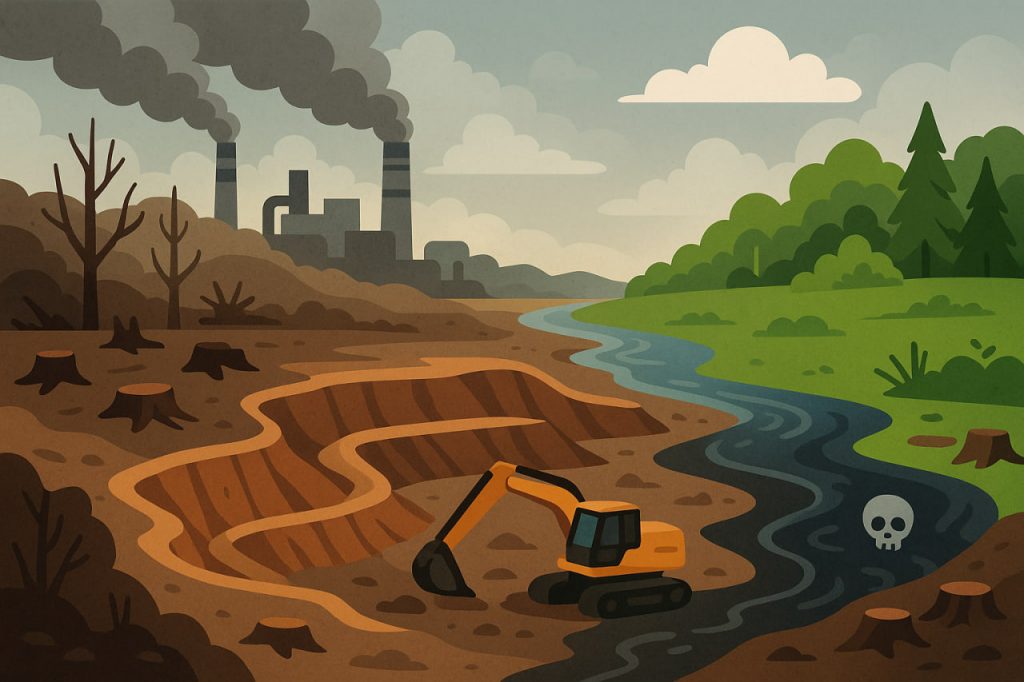The extraction of minerals and fossil fuels has powered human progress for centuries, fueling industries, transportation, and modern technology. However, this progress has come at a significant environmental cost. Mining — whether for coal, metals, oil, or rare earth elements — disrupts ecosystems, pollutes air and water, and contributes to climate change. Understanding the ecological impact of mining is essential for creating sustainable ways to balance human needs with the planet’s health.
Destruction of Landscapes and Ecosystems
Mining often begins with deforestation and land clearing, which destroys habitats for countless species. Open-pit mining, in particular, leaves massive scars on the Earth’s surface — entire hills and valleys are removed to access the minerals below. This destruction causes soil erosion, loss of biodiversity, and disruption of natural water flow. Animals that once thrived in these areas are forced to migrate or perish due to habitat loss.
Underground mining, while less visible, can still cause subsidence — the collapse of land above tunnels — leading to sinkholes, destroyed vegetation, and damage to local infrastructure. Even after a mine is closed, landscapes often remain barren and unable to support healthy ecosystems for decades.
Water Pollution and Toxic Waste
One of the most serious environmental consequences of mining is water contamination. Chemicals like cyanide, mercury, and sulfuric acid are often used to extract metals from rock. When these substances leak into rivers and groundwater, they poison aquatic life and make water unsafe for humans. Heavy metals such as lead, arsenic, and cadmium accumulate in the food chain, causing long-term ecological damage.
In coal mining regions, acid mine drainage — a chemical reaction between exposed rock and air — creates highly acidic water that can spread for kilometers, turning streams orange and killing all life within them.
Air Pollution and Greenhouse Gases
Mining and processing operations release vast amounts of dust and toxic gases, including sulfur dioxide, methane, and carbon dioxide. These emissions degrade air quality and contribute to global warming. Coal mining alone is responsible for significant methane emissions — a greenhouse gas over 25 times more powerful than CO₂ in trapping heat. Workers and nearby communities are also at risk of respiratory diseases due to prolonged exposure to dust and fine particles.
Depletion of Natural Resources
Mining is inherently unsustainable because it extracts finite resources. Minerals like copper, lithium, and rare earth elements — crucial for electronics and renewable technologies — are being consumed faster than they can be replaced. Overexploitation of these materials not only endangers ecosystems but also creates geopolitical tensions and economic instability as supplies dwindle.
Impact on Local Communities
The social effects of mining can be just as harmful as the environmental ones. In many parts of the world, local populations suffer from contaminated water, deforestation, and loss of farmland. Indigenous peoples are often displaced from ancestral lands, and poor working conditions expose miners to accidents and diseases. While mining can create jobs, the long-term consequences for communities and nature are often devastating.
Paths Toward Sustainable Mining
Reducing the environmental footprint of mining requires innovation and regulation. Some solutions include:
- Recycling and reusing metals to reduce new extraction.
- Using cleaner technologies such as electric mining equipment and water treatment systems.
- Rehabilitating mine sites by planting vegetation and restoring soil.
- Strict environmental laws and monitoring, ensuring companies take responsibility for cleanup.
Emerging practices like urban mining — recovering valuable metals from electronic waste — also offer an eco-friendly alternative to traditional extraction.
Interesting Facts
- Each ton of gold mined can generate over 20 tons of toxic waste.
- The mining industry is responsible for nearly 10% of global carbon emissions.
- Open-pit mines can reach depths of over 1,000 meters, permanently altering local geography.
- Some countries now require companies to create a reclamation plan before mining begins.
Glossary
- Acid mine drainage — acidic water formed when minerals react with air and water during mining.
- Deforestation — large-scale removal of trees and vegetation, often for industrial purposes.
- Methane — a potent greenhouse gas released during coal and gas extraction.
- Subsidence — the sinking or collapsing of land due to underground mining.
- Urban mining — recovering valuable materials from electronic or industrial waste instead of natural deposits.


